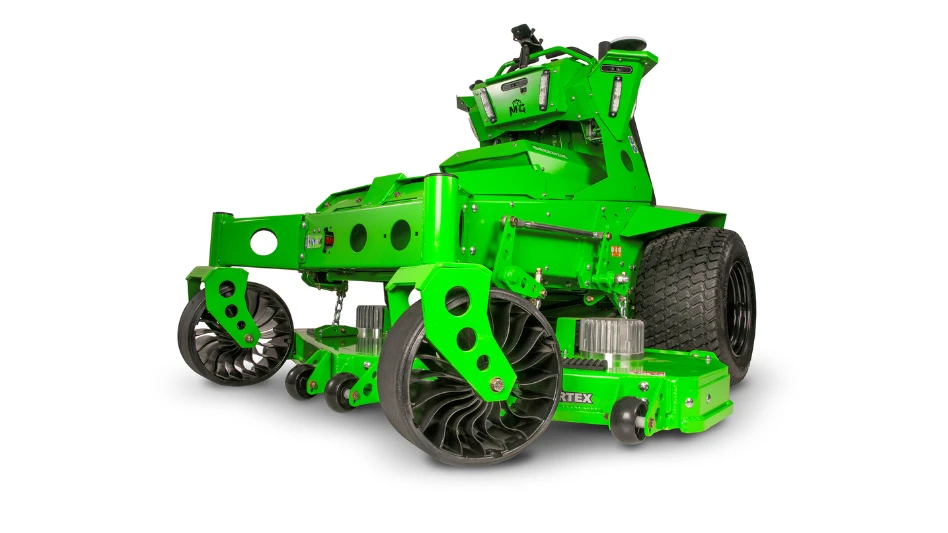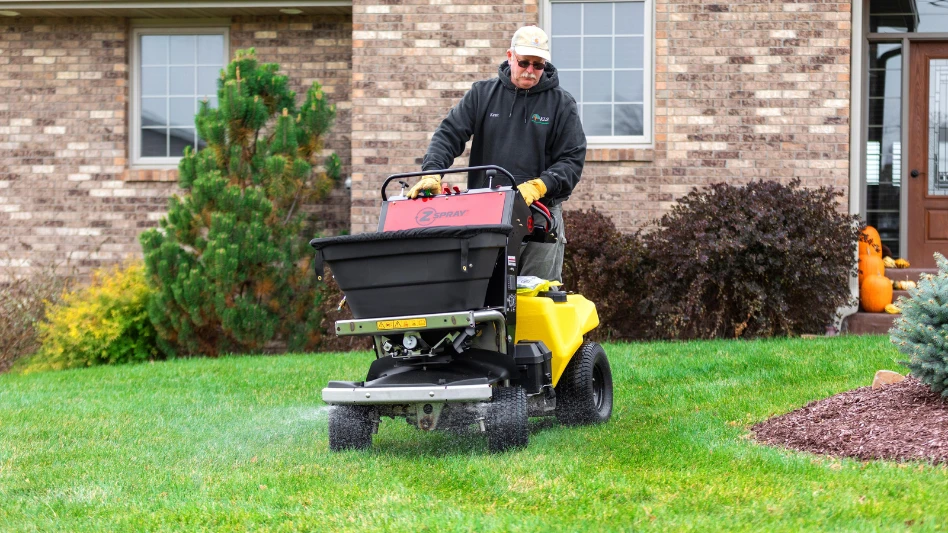With almost eight acres of park frontage that incorporates almost 10,000 native plants from 100 different species (including 19 different trees and 85 different shrub types), the design of the Inland Empire Utilities Agency facility in Chino, Calif., is impressive in its own right. But the building has a unique accolade. It became the first public agency facility in the U.S. to receive a LEED (Leadership in Energy and Environmental Design) Platinum rating, as well as the largest U.S. site with such a rating.
Needless to say, on-site recycled water and efficient drip irrigation proved to be an important part of the facility’s design, allowing the IEUA to meet its water demands. But for all its successes, drip irrigation systems still see plenty of competition from spray irrigation systems.
| ONLINE EXTRA |
Click here to see a PDF chart illustrating the anatomy of a drip irrigation system. |
“There are many different reasons to choose drip irrigation over spray – or vice versa,” says Erik Christiansen, independent irrigation consultant with Des Moines, Iowa-based EC Design Group. “Maintenance people already have an idea of what they want to use. If subsurface irrigation has been successful, they want to continue with that. If the spray head pop-up application works, they may prefer spray/bubbler zones.”
Drip irrigation is practical for both commercial and residential landscapes. But for large beds and large turf areas, spray systems can trump drip or subsurface irrigation.
“Looking at some of our other projects – turf in particular – people like the pop-up spray head configuration,” he says. “At times, it may be difficult to maintain an acceptable texture and color for turf with drip or subsurface irrigation. The spray head system may have a better distribution because it’s not relying on the adhesion of the soils to spread the moisture throughout the turf root zone.”
Spray also holds promise in innovative new products.
“What’s exciting right now is a new generation of spray nozzles, one being Toro’s new Precision Series spray nozzle,” Christiansen says. “We’re realizing almost a 30 percent water savings with some of these new generation spray heads.”
In fact, Toro Precision Series Spray Nozzles were named the 2008 New Product of the Year for Turf/Landscape at the Irrigation Association’s (IA) Show held Nov. 2-4 in Anaheim, Calif.
“Drip and subsurface are fairly cut and dry if you have xeriscaping or native plants, but within some markets people still want to see green grass,” Christiansen says. “We have a really efficient product to use in already existing markets, such as cities and municipalities where governments are interested in the new generation of spray nozzles. People realize that a 30 percent savings is substantial. It’s not only water involved; it also takes energy to pump more water. Every yard saving thousands of gallons is a good testimonial to the technology.”
Much of this technology has been driven by the need to apply water more efficiently and effectively. And Christiansen notes that with the new nozzles, water distribution is much purer.
“Manufacturers have figured out a way to distribute the water on turf without the misting or drift – even in the face of wind to some degree. There’s a lot going on in both drip and spray irrigation these days.”
Where Drip Works
Tom Campbell says even though he’s thinking outside the box for each of his clients’ different sites, he always has irrigation on his mind. Campbell has been in business in northern California for 25 years and has focused on water conservation for the last ten years. In 2004, he started a landscaping and irrigation company – Water Scout – around the same time a lot of the companies were coming out with their ET-based and moisture sensor systems.
“They were introducing this in both the commercial and private sectors,” Campbell says. “I didn’t want the industry to get a black eye due to improper installation of this equipment. I learned as much as I could. Using the sensors with drip irrigation is absolutely spectacular.”
For hillside planting, Campbell has found Netafim to be a good system.
“The setup of the zone is much easier,” he explains. “You don’t have to trench and disturb that hillside anymore. Just staple the drip line down to the hillside, and be sure the emitters are in the center between the two plants or on each plant. It’s so easy.”
If an individual wanted to do the same in a spray zone, Campbell says, the trenching would be enormous. The hillside would be compromised and spraying would be required at top, center and bottom zones.
“The application rate with spray is a lot faster than a drip zone, but drip is the only way to go in such an environment,” Campbell adds. “Trenching compromises the stability of a hillside, depending on how steep it is. With drip, once you have your zones and manifold set up, you just take the lateral line and run with it.”
Drop It Down
Spray irrigation can be less expensive to install than drip. However, according to Jeffrey Knight, central regional education manager with Phoenix-based Ewing Irrigation, the uniformity and efficiency of drip irrigation far exceeds that of spray systems.
“It’s a pretty easy sell, even in cases where the parts cost more than those of a conventional spray system,” Knight says. “It is cheaper to install drip and faster, because you don’t have to trench through an existing bed to install spray heads. You’re just laying it under the mulch, and that goes pretty fast.
“People have been doing subsurface irrigation under turf, so I feel the jury is still out on that. Some have had success with it and I’ve seen other systems that weren’t necessarily installed or maintained correctly – and those ended up being a nightmare.”
As a whole, Knight feels drip is extremely versatile and efficient.
“Its uses range from flower beds to hanging baskets to a vineyard,” he explains. “This makes it something the contractor has got to have in his repertoire to offer the customer – you can almost do it all with drip.”
Knight says installation doesn’t get any faster or easier than with an existing landscape bed: A contractor can come in with a PVC riser and lay drip irrigation on top of the ground, instead of installing spray heads every 10 to 15 feet.
“There are other ways of installing drip that take a lot of time,” he adds. “Everything depends on how you’re doing it. Installing drip could be more expensive, or it could be cheaper. Drip also uses water more efficiently, so 95 percent of the water applied with the dripper actually has a chance of being seen by the plant. With spray irrigation, a lot of times you have to over-water in order to make up for inefficiency.”
Learning Curves
From a profitability standpoint, Dave Palumbo, Rain Bird drip product sales manager, points out that many variables with drip can also mean wide differences in cost of installation.
Sponsored Content
Gaeta Recycling: Driving efficiency and sustainability with SENNEBOGEN material handlers
Gaeta Recycling, a family-owned business in Paterson, New Jersey, has been a cornerstone of the community since 1935. Led by fifth-generation owner and President Michael Portannese, the company specializes in solid waste and recycling. It manages 30 municipal contracts and handles up to 720 tons of material daily at its transfer station.
Sponsored Content
Gaeta Recycling: Driving efficiency and sustainability with SENNEBOGEN material handlers
Gaeta Recycling, a family-owned business in Paterson, New Jersey, has been a cornerstone of the community since 1935. Led by fifth-generation owner and President Michael Portannese, the company specializes in solid waste and recycling. It manages 30 municipal contracts and handles up to 720 tons of material daily at its transfer station.
Sponsored Content
Gaeta Recycling: Driving efficiency and sustainability with SENNEBOGEN material handlers
Gaeta Recycling, a family-owned business in Paterson, New Jersey, has been a cornerstone of the community since 1935. Led by fifth-generation owner and President Michael Portannese, the company specializes in solid waste and recycling. It manages 30 municipal contracts and handles up to 720 tons of material daily at its transfer station.
Sponsored Content
Gaeta Recycling: Driving efficiency and sustainability with SENNEBOGEN material handlers
Gaeta Recycling, a family-owned business in Paterson, New Jersey, has been a cornerstone of the community since 1935. Led by fifth-generation owner and President Michael Portannese, the company specializes in solid waste and recycling. It manages 30 municipal contracts and handles up to 720 tons of material daily at its transfer station.
Sponsored Content
Gaeta Recycling: Driving efficiency and sustainability with SENNEBOGEN material handlers
Gaeta Recycling, a family-owned business in Paterson, New Jersey, has been a cornerstone of the community since 1935. Led by fifth-generation owner and President Michael Portannese, the company specializes in solid waste and recycling. It manages 30 municipal contracts and handles up to 720 tons of material daily at its transfer station.
One large factor is the depth at which a drip system might be installed. A system that’s simply covered with mulch will be less expensive than one that must be installed at greater depth.
“Often, the cost of equipment with drip is less,” Palumbo says. “With a system installed on grade, it also might involve less labor cost than a buried installation.”
Palumbo has found some resistance to drip from certain longtime sprinkler users.
“There might be a perception that a drip system has a higher level of maintenance than a spray system,” Palumbo explains. “I say its maintenance is simply different than traditional irrigation, and it has its own learning curve to it. Nothing is maintenance-free, but then again you don’t have to do as much weeding with drip as with spray. With spray, you’re promoting weed growth in the area between plants, where the spray reaches.”
But using drip irrigation doesn’t necessarily mean you’re going to save water, according to Palumbo. It’s possible to over-water with drip, too.
“I teach that using drip isn’t a sure way to save water,” he says. “Doing the proper calculations and estimating how much water your plants need saves you water.”
More Than Meets the Eye
Ensuring profitability with irrigation installations of any kind is not simple, according to Stuart Spaulding, customer service supervisor at DIG Corporation, an irrigation product manufacturer in Vista, Calif.
“There are many factors that affect profitability in landscape irrigation contracting,” Spaulding says. “One of the most significant is the bid, which is partially based on the irrigation products that will be installed. Another is the knowledge and skill level of the installation crew. Yes, drip can be more profitable than spray irrigation. However, it can be less profitable as well.”
Though forms of drip technology have been around for 30 to 40 years, the recent scarcity and high price of water has meant an increase in drip’s popularity.
“The fact that drip systems are generally more efficient than spray systems is undisputed,” Spaulding says. “However, any system not maintained properly can waste lots of water.”
Get curated news on YOUR industry.
Enter your email to receive our newsletters.
Explore the December 2008 Issue
Check out more from this issue and find your next story to read.
Latest from Lawn & Landscape
- How I built a Top 100 company
- Grow your business with mosquito control
- LandCare adds 2 branches in SoCal, promotes Aleman to branch manager
- Spray them away
- PERC helps debut propane direct-injection fuel system at ACT Expo 2025
- Retargeting Ads – A Secret Weapon for Growing Your Lawn Care Business
- Leading a growing company
- Project EverGreen launches Clean Air Calculator






